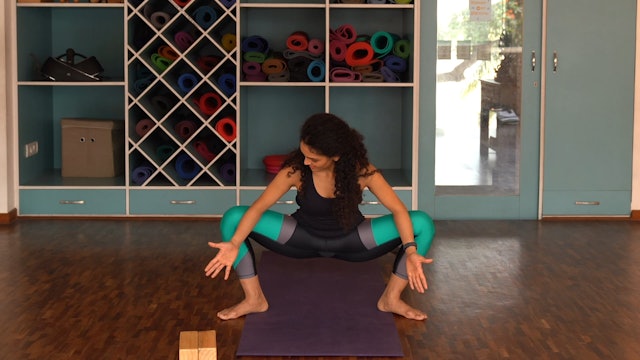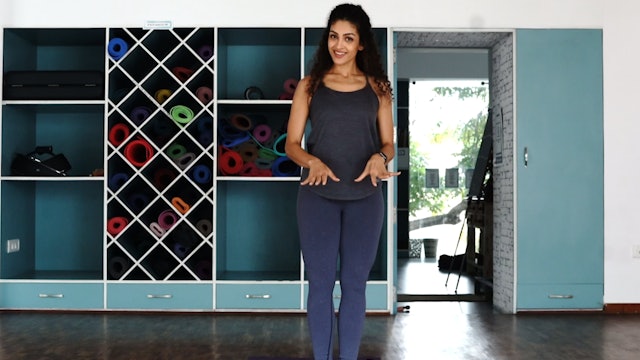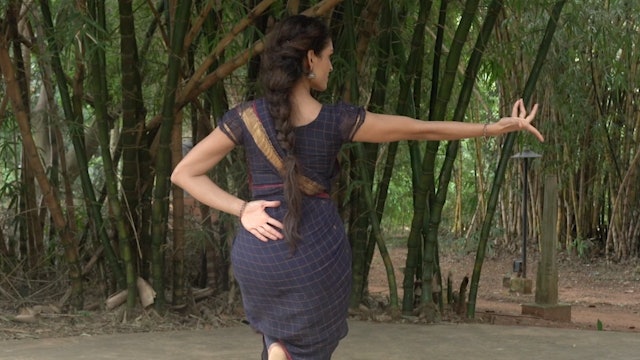Playlist 28
The Playlist progresses into the Nupallavi and Sahityam of the Tillana while continuing to introduce and address some basics. The systematic progression of jumps is necessary as we move into the second set of adavus, and this series moves into jumps in the turned out position.
The Kartharee adavu variations are introduced, and the second korwe adavu is also introduced.
-
Hip Openers
This series can be practiced after a basic warm up, before beginning an Adavu practice.
The hip opener series will help you navigate through tight hips. It will help you mobilise your hips and enable you to push your thighs back while sitting in Araimandi. Please do this in combination with str...
-
Hip Stabilisers: Gluteals, rotators, adductors.
This works on all the muscles that stabilise at the hip joint. These muscles are needed to lunge with stability, squat with proper muscular engagement and also balance on one leg. These muscles will help the dancer develop stability while dancing and also prevent injuries in the process.
You mu...
-
Skip jumps
This series will deal with a number of short exercises that will help the student develop awareness and alignment when jumping. It must be done in combination with the strength exercises to have maximum benefit.
Please commence this exercise only after, warming up your ankles, and doing some bal...
-
Horse jump prep
This series will deal with a number of short exercises that will help the student develop awareness and alignment when jumping. It must be done in combination with the strength exercises to have maximum benefit.
The horse jump prep, introduces a jump in parallel where the legs use the udvahitam ...
-
Cat jump
Please do this jump only after doing all the previous jumps in this series. It must be done in combination with the strength exercises to have maximum benefit.
Please commence this exercise only after doing hip openers, warming up your ankles, and doing some balance work with the standing and li...
-
Turned out Jumps
Please do this jump only after doing all the previous jumps in this series. It must be done in combination with the strength exercises to have maximum benefit.
Please commence this exercise only after doing hip openers, warming up your ankles, and doing some balance work with the standing and li...
-
Pakkadavu 3
Pointers for Pakkadavu 3:
Keep your shoulders down when lifting your arms.
Make sure your arms do not go too far back.
Follow your arm and keep your gaze toward the wrist of the arm you are bending away from.
Make sure you keep your thighs pushing back while retaining Swastikam in your feet.
... -
Parval Adavu 3
Paraval literally means to spread. Some schools of thought also call the Paraval adavu, the 'Pakkadavu' as it moves to the side while sliding. Some others change the name based on the way the foot articulates with the floor. A few of the types of Paraval, can be referred to as Marditam adavau, as...
-
Bramari Adavu
Bramari literally means to turn. The first Bramari adavu is introduced in the second set of Adavus, the other varieties will be introduced subsequently. It is important to keep the eyes focussed at a particular point and turn the head faster than the body.
Things to keep in mind:
- When stretc... -
Bramari Adavu 2
Bramari literally means to turn. The second Bramari adavu that we practise in the Raadha Kalpa method introduces, quarter, half and full turns.
These turns are used in choreography to change direction with precision.
Things to keep in mind:
- The lengthening of the bent knee and the turn happ... -
Bramari Adavu 3
Bramari literally means to turn. The third Bramari adavu that we practise in the Raadha Kalpa method introduces half turns while using the same technique as the previous Bramari.
These turns are used in choreography to change direction with precision.
Things to keep in mind:
- The lengthening o... -
Bramari Adavu 4
Bramari literally means to turn. The fourth Bramari adavu that we practise in the Raadha Kalpa method introduces full turns while using the same technique as the third Bramari adavu.
The arm movement is varied in this turn just so students can practise a different combination of upper an lower ...
-
Korwe Adavu 1
The Korwe adavu is a combination of previously introduced foot and body articulations. It is called a Korvey adavu as it cannot be placed into any specific category. It has a Tattu, naatu, Bramari, Serikal amongst other movements. Some Korwe adavus also use a Kudittam in the feet.
Things to kee...
-
Korwe Adavu (utplavana 1 )
The Korwe adavu is a combination of previously introduced foot and body articulations. It is called a Korvey adavu as it cannot be placed into any specific category. It has a Tattu, naatu, Bramari, Serikal amongst other movements. Some Korwe adavus also use a Kudittam in the feet.
Things to kee...
-
Turning horse jump
Please do this jump only after doing all the previous jumps in this series. It must be done in combination with the strength exercises to have maximum benefit.
Please commence this exercise only after warming up your ankles, and doing some balance work with the standing and lifted leg turned ou...
-
Kartharee adavu 2/3: Instructions
The Kartharee adavu is a movement that begins with a jump, followed by the crossing of the legs. The name could come from the hasta that is used or from the fact that the legs cross.
The bends of the bodies vary in the various types of Kartharee adavu. We usually practice this Adavu to a three c...
-
Kartharee Adavu 2
The Kartharee adavu is a movement that begins with a jump, followed by the crossing of the legs. The name could come from the hasta that is used or from the fact that the legs cross.
The bends of the bodies vary in the various types of Kartharee adavu. We usually practice this Adavu to a three c...
-
Kartharee Adavu 3
The Kartharee adavu is a movement that begins with a jump, followed by the crossing of the legs. The name could come from the hasta that is used or from the fact that the legs cross.
The bends of the bodies vary in the various types of Kartharee adavu. We usually practice this Adavu to a three c...
-
Kartharee Adavu 1
The Kartharee adavu is a movement that begins with a jump, followed by the crossing of the legs. The name could come from the hasta that is used or from the fact that the legs cross.
The bends of the bodies vary in the various types of Kartharee adavu. We usually practice this Adavu to a three ...
-
Korwe Adavu 2: Instructions
The Korwe adavu is a combination of previously introduced foot and body articulations. It is called a Korvey adavu as it cannot be placed into any specific category. It has a Tattu, naatu, Bramari, Serikal amongst other movements. Some Korwe adavus also use a Kudittam in the feet.
Things to keep...
-
Korwe Adavu 2
The Korwe adavu is a combination of previously introduced foot and body articulations. It is called a Korvey adavu as it cannot be placed into any specific category. It has a Tattu, naatu, Bramari, Serikal amongst other movements. Some Korwe adavus also use a Kudittam in the feet.
Things to keep...
-
Jatiswaram: Raga Rasikapriya
The second piece that is traditionally presented in a Margam is a Jatiswaram. A Jatiswaram is named as such because it is a combination of a Jathis and Swarams. It begins with a Jathi typically followed by the Pallavi, Anupallai and Charanams, to which multiple Korwes are choreographed.
This pa...
-
Tillana: Raga Vallachi
Tillana
Raga : Vallachi
Adi Tala
Composer: Dwaraki Krishnaswamy
Choreography: Guru Narmada, (reinterpreted by Rukmini Vijayakumar)A Tillana is usually the last piece in the performance of a Margam. Adapted from the Tarana, of Hindustani music, the Tillana reflects the joy of finally reaching th...
-
Tillana : Anupallavi 1
Tillana
Raga : Vallachi
Adi Tala
Composer: Dwaraki Krishnaswamy
Choreography: Guru Narmada, (reinterpreted by Rukmini Vijayakumar)A Tillana is usually the last piece in the performance of a Margam. Adapted from the Tarana, of Hindustani music, the Tillana reflects the joy of finally reaching th...

























